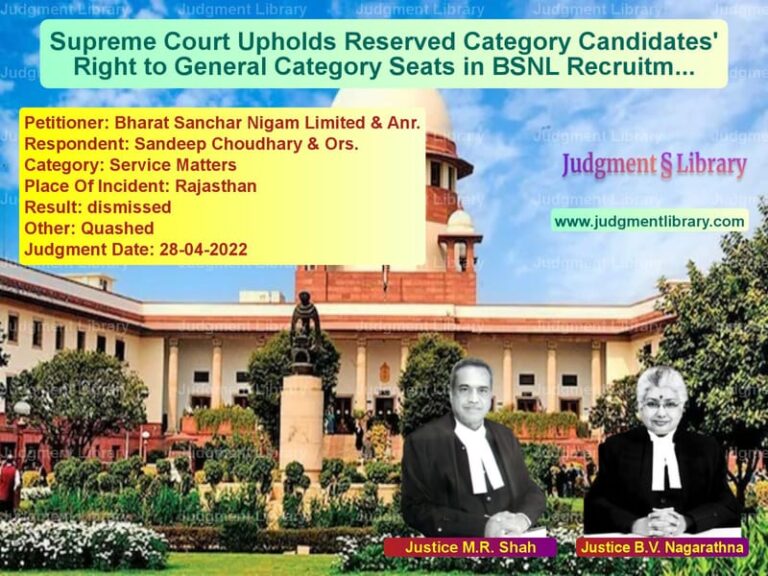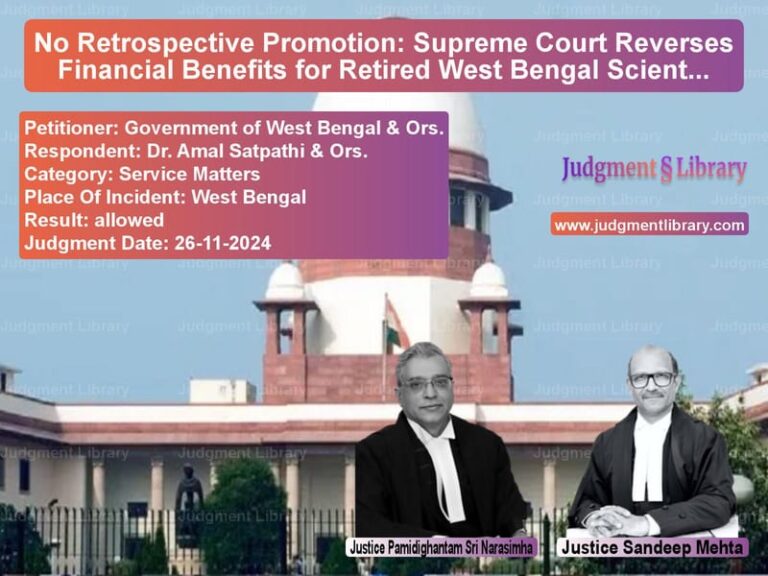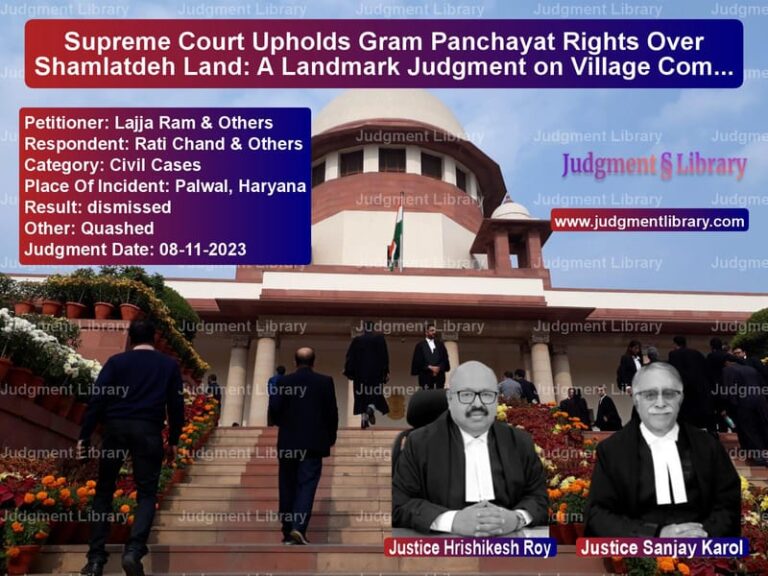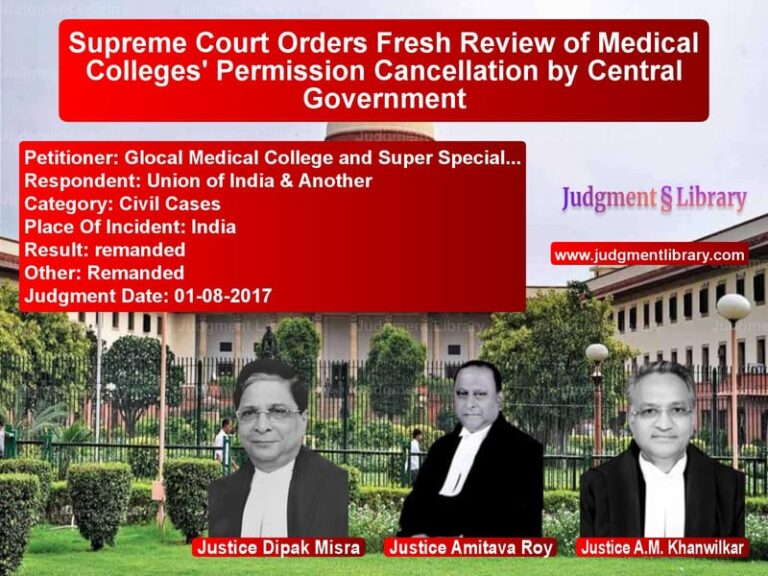Supreme Court Clarifies Operational Creditors’ Claim in Insolvency Process
The Supreme Court of India, in a recent judgment, addressed an important issue related to insolvency proceedings under the Insolvency and Bankruptcy Code (IBC). The case involved NTPC Ltd. (Simhadri Project) as the appellant and Rajiv Chakraborty as the respondent, concerning the categorization of claims in an Information Memorandum prepared by the Resolution Professional. The ruling provides clarity on the treatment of claims under adjudication in insolvency proceedings and affirms that unresolved claims remain intact until legally adjudicated.
Background of the Case
The dispute arose when NTPC Ltd. (Simhadri Project) contested the classification of its claim in the Information Memorandum during the insolvency resolution process. NTPC argued that its claim should have been categorized under ‘Claims of Operational Creditors’ instead of being listed under ‘Other Creditor Claims (excluding Related Party Claims and Employees and Workmen Claims) as on July 17, 2019.’ The matter was brought before the National Company Law Tribunal (NCLT) and subsequently the National Company Law Appellate Tribunal (NCLAT), both of which ruled against NTPC.
Aggrieved by these decisions, NTPC approached the Supreme Court, contending that the categorization affected its rights in the insolvency process.
Arguments by the Petitioner
NTPC Ltd., represented by its counsel, argued the following points:
- The claim should have been reflected under ‘Claims of Operational Creditors’ to ensure that it is properly accounted for in the resolution process.
- The misclassification could lead to an improper resolution plan that fails to consider NTPC’s legitimate claim.
- The Information Memorandum should accurately reflect all claims in appropriate categories, as it plays a crucial role in the resolution process.
Arguments by the Respondent
The respondents, including the Resolution Professional and the Committee of Creditors, countered NTPC’s claims with the following points:
- NTPC’s claim had already been acknowledged in the Information Memorandum under the category of ‘Other Creditor Claims.’
- The resolution process does not determine the legitimacy or priority of claims; that is to be done through separate adjudication.
- Since NTPC’s claim was still under arbitration, it was correctly categorized as ‘claims under adjudication.’
Supreme Court’s Observations
The Supreme Court carefully examined the issue and made the following key observations:
- The Information Memorandum serves only as a record of the financial position of the company under insolvency and does not determine the validity or priority of claims.
- The claim of NTPC had been duly recorded in the memorandum, and its status as ‘under adjudication’ was appropriate given that arbitration proceedings were ongoing.
- The Resolution Professional does not have the authority to accept or reject claims; that power lies with the appropriate legal forums.
In its judgment, the Supreme Court categorically stated:
“The purpose of the memorandum is only to provide relevant information regarding the financial position of the company in question. It is not about deciding the claim or disregarding the claim amount, if it exists in law.”
The Court further clarified that NTPC’s claim would not be extinguished unless adjudicated by a competent authority:
“The appellant’s claim would not get extinguished unless it is adjudicated upon by a competent forum or by operation of law.”
Final Judgment
The Supreme Court disposed of the appeal with the following directives:
- NTPC’s claim remains intact and must be adjudicated upon by the arbitrator.
- The resolution applicant and Committee of Creditors must consider NTPC’s claim as part of the resolution process.
- If NTPC has any grievance regarding the final resolution plan, it may seek legal recourse.
- The interim order previously granted in the matter was vacated.
- The concerned authorities were directed to expedite the resolution process.
Conclusion
This ruling by the Supreme Court provides critical clarity on the treatment of claims in insolvency proceedings. It underscores that an Information Memorandum is merely a financial record and does not determine the validity of claims. The judgment reinforces the principle that claims under adjudication retain their status and must be resolved through appropriate legal mechanisms. For creditors involved in insolvency proceedings, this decision affirms that their rights remain protected despite classification disputes in the Information Memorandum.
Petitioner Name: NTPC Ltd. (Simhadri Project).Respondent Name: Rajiv Chakraborty.Judgment By: Justice A.M. Khanwilkar, Justice B.R. Gavai, Justice Hrishikesh Roy.Place Of Incident: India.Judgment Date: 16-11-2020.
Don’t miss out on the full details! Download the complete judgment in PDF format below and gain valuable insights instantly!
Download Judgment: NTPC Ltd. (Simhadri vs Rajiv Chakraborty Supreme Court of India Judgment Dated 16-11-2020.pdf
Direct Downlaod Judgment: Direct downlaod this Judgment
See all petitions in Bankruptcy and Insolvency
See all petitions in Corporate Compliance
See all petitions in Company Law
See all petitions in Judgment by A M Khanwilkar
See all petitions in Judgment by B R Gavai
See all petitions in Judgment by Hrishikesh Roy
See all petitions in dismissed
See all petitions in supreme court of India judgments November 2020
See all petitions in 2020 judgments
See all posts in Corporate and Commercial Cases Category
See all allowed petitions in Corporate and Commercial Cases Category
See all Dismissed petitions in Corporate and Commercial Cases Category
See all partially allowed petitions in Corporate and Commercial Cases Category







